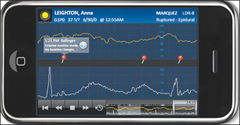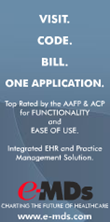HIMSS from a Grunt’s Perspective
“Healthcare Information and Management Systems Society” We all know our worlds of healthcare and technology have become bloated with cryptic acronyms, but this is one I appreciate. Pronounce “HIMSS” and then try the extended version. Pretty much trips on the way off your tongue, eh? So, thank God for acronyms, overused though they may be. (One issue: HIMSS does have a slight odor of male testosterone-laden bigotry – they could have gone with HIRSS, Healthcare Information and Restructuring Systems Society, right, Inga?)
I’ve attended numerous conferences in my time and, while I have known of HIMSS for years, this was the first time I have attended their annual event. The good Mr. HIStalk and the lovely Inga helped inspire my drive to attend with a kindly invite to the HIStalk reception at the Trump Hotel. (Thanks, guys, and more on that in a bit.) From the recently deceased TEPR (I may be premature on that, but life signs are difficult to detect … as is their Web site) to the American Academy of Pediatrics as well as other assorted groups, I have to say, HIMSS in Chicago this year outdoes any I’ve seen. As a lowly solo pediatrician from a small Midwestern town, I’d like to offer up a few “grunt-in-the-trenches” observations.
First, though I hear the attendance numbers were down, it is still a pretty massive crowd. Second, though I hear the vendors’ booths were also down – fewer, smaller, and with decreased booth babes – it is still a heap of ground to cover. Third, comparatively, many more folks were dressed for business , including business footwear, than in other events I’ve seen which is impressive considering all the ground that needs to be trodden from ‘miles’ of booths to the far distant lecture halls. I’m still limping a bit. (Spot any highlight-able footwear, Inga?)
A note on the keynote (1 of 4): I know many of the cynical sort have pooh-poohed the inclusion of Dennis Quaid as a keynote speaker, but I would contend he is a loving father who encountered a frightening flaw in our medical system and cared enough to try to help others avoid a similar scenario. Not as smooth addressing us as you might expect an actor to be, his non-verbal language suggested authenticity behind his words. His impassioned description of his emotional trauma lends a human face to the problems we are all attempting to address. His (perhaps overly-stated) appreciation for medical and HIT peeps, to me, seemed genuine. As a pediatrician, a father, and an HIT fan, I liked him.
Speaking of the keynote, I’d also offer props to the production crew. I used to be a sound engineer (big time rock-n-roll-n-such like the Eagles, Linda Ronstadt , Charlie Daniels, Randy Newman, Funkadelics, Stylistics, B.B. King, Pure Prairie League, etc.) and from the basis of my experience, I think the audio and video production teams deserve a big back pat. Well done, guys! I did hear one suggestion: they might consider some big screens about halfway back as the hall was so long it was tough to see from the cheap seats. (I sat near the camera guys as their chosen area was the audio sweet spot. Old habit.)
Now, granted, I couldn’t be in a tenth of the talks or spend prolonged time at any of the booths, but it seemed the overriding topic on virtually everyone’s lips was how their particular project/product/process was THE thing that Obama bucks should back to bolster the beleaguered HIT behemoth beyond the bipping point. (I know, tipping point, but I needed another “b.”)
My personal favorite, besides discussing the nude beach, “Moonstone,” with Rhode Island Senator Sheldon Whitehouse, was a discussion of Health Record Banks (HRBs, for those keeping acronym counts) given by Drs. Deborah Peel and Bill Yasnoff. Love the community aspect and the patient-centricity. Worth a look here; their first banks are now operational in Washington State.
I also LOVE the new partnering of Eclipsys with Medicity to create the Eclipsys Health Xchange solution. I see big winds blowing up from this. I was fortunate enough to get one of their blue backpacks emblazoned with “Meaningful Use?” Thanks, guys. (Full disclosure: I use, and love, Eclipsys’ PeakPractice– have ever since the old Bond CLINICIAN days. A nod and a tip o’ the hat to Travis Bond.)
Another intriguing offering I enjoyed is Doctations and their “online healthcare community.” I like things which “empower the doctor-patient relationship” while minimizing the silo effect. Their founder, Dr. Louis Cornacchia, is an unassuming neurosurgeon with great enthusiasm and an enjoyable vision.
Dr. Eric Fishman was around with his camera crew recording new segments for his EHRTV.com, sort of a steroided YouTube for EHRs. Very high quality video briefs, all about EHRs. Kudos, Eric.
I was fortunate enough to watch athenahealth’s Jonathan Bush give his acceptance speech for the HIStalk “Healthcare IT Industry Figure of the Year” HISsie Award as well as watch him record a moment with Dr. Fishman. I’ve seen lots of legitimate ADHD in my day, but I give, hands down, all honors to Jonathan for making extreme hyperactivity an honorable, perhaps even desirable, brain chemistry imbalance. He’s a riot!
I don’t drink, but I enjoyed OnBase’s sports bar/Cheers booth. A Norm and Cliff-ish home away from home booth when not at Epic’s digital-fireplace-toasty-home booth. Plus, besides my blue backpack, they had the only other freebie I gathered: an OnBase hardball. My eight year old said, “Yeah! Cool!”
A quick shout out to my pediatric pals, Drs. Feiten, Loveys, Schneider, and Marcus. More brave grunts at HIMSS from the pediatric HIT trenches of this brave new world.
Last, but most definitely not least, I believe I may have identified the illustrious Mr. H, though I would NEVER, EVER tell. The seductive Inga, however, remains elusive even though she is BFF with one of my favorite people, Amy Gleason. Amy looked lovely in her official green “Inga’s BFF” sash. I looked and looked at all the ladies’ feet, figuring the nicest female footwear would be a drop dead giveaway, but to no avail. Inga and Mr. H do throw a nice shindig, but I may need to offer up my old sound engineering skills for next year. For two otherwise workaday grunts, they’ve had a pretty impressive impact on the birth of this new industry. (I wonder if Jonathan Bush’s extreme Inga fantasies may have even had an impact on his marital status?)
To Mr. H and Inga, and to all who continue to push the HIT stone uphill, I offer a tip of the elbow and a bold "Na Zdorovie!"

Dr. Gregg Alexander is a grunt-in-the-trenches pediatrician and geek. His personal manifesto home page…er..blog…yeh, that’s it, his blog – and he – can be reached through http://madisonpediatric.com or doc@madisonpediatric.com.









The article about Pediatric Associates in CA has a nugget with a potentially outsized impact: the implication that VFC vaccines…